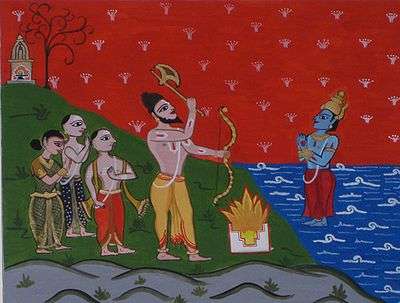Nambudiri

The Nambudiri Brahmins, also transliterated Namboothiri or Namputhiri, are Hindu Brahmins from the Indian state of Kerala.
History
Nambudiri mythology associates their immigration to Kerala from the banks of Narmada, Krishna and Kaveri rivers with the legendary creation of Kerala by Parasurama, an avatar of Vishnu.[1]
Cyriac Pullapilly has noted a theory that the Nambudiris are associated by some with the development of the caste system in Kerala,[2] Pullapilly refers to other theories also but of this one he says that although other Brahmin influences like sthanika tulu brahmins had existed in the area since at least the 1st-century AD, there was a large influx of these people (nambudiri brahmins) from around the 8th-century when they acted as priests, counsellors and ministers to local kings and invading Aryan princes. At the time of their arrival the non-aboriginal local population had been converted to Buddhism by missionaries who had come from the north of India and from Ceylon. The Brahmins used their priestly and advisory relationship with the invading forces to assert their beliefs and position. Buddhist temples and monasteries were either destroyed or taken over for use in Hindu practices, thus undermining the ability of the Buddhists to propagate their beliefs. The Brahmins treated almost all of those who acceded to their priestly status as Shudra, permitting only a small number to be recognised as Kshatriya, these being some of the local rulers who co-operated with them. By the 11th-century, this combination of association with kings and invaders, and with the destruction or take-over of Buddhist temples, made the Brahmins by far the largest land-owning group in the region and they remained so until very recent times. The origins of Malayalam as a language is also attributed to the Nambudiri Brahamin's mixing of Sanskrit and the local Tamil language. Their dominating influence was to be found in all matters: religion, politics, society, economics and culture.[2]
Customs
Marriage with Nairs
The Nambudiri Brahmin tradition which limited the extent of marriage within their own caste led to the practice of hypergamy with the Nair community. Kathleen Gough notes that
These hypergamous unions were regarded by Brahmans as socially acceptable concubinage, for the union was not initiated with Vedic rites, the children were not legitimized as Brahmans, and neither the woman nor her child was accorded the rights of kin. By the matrilineal castes, however, the same unions were regarded as marriage, for they fulfilled the conditions of ordinary Nayar marriage and served to legitimize the child as an acceptable member of his matrilineal lineage and caste."[3]
The disparity in caste ranking in a relationship between a Brahmin man and a Nair woman meant that the woman was unable to live with her husband(s) in the Brahmin family and so remained in her own family. The children resulting from such marriages always became Nairs. K. M. Panikkar argues that it is this type of relationship that resulted in the matrilineal and matrilocal system.[4] It has also been argued that the practice, along with judicious selection of the man who tied the thali, formed a part of the Nair aspirational culture whereby they would seek to improve their status within the caste. Furthermore, that
... among the higher-ranking Nayars (and Kshatriyas and Samantans) in contradistinction to the "commoner" Nayars, no two subdivisions admitted to equal status. Thus the relations set up by the tall-rite [ie: the thalikettu kalyanam] and the sambandham union were always hypergamous.[5]
Although it is certain that in theory hypergamy can cause a shortage of marriageable women in the lowest ranks of a caste and promote upwards social movement from the lower Nair subdivisions, the numbers involved would have been very small. It was not a common practice outside the higher subcaste groups.[6]
Attire
Traditionally, Nambudiri men wore a cloth around the waist called a mundu. When they had to travel, they wore a simple cloth around the waist called a thorthu (or thortumundu). When they had to travel, they wore two sets of cloth in addition known as a vasthram.[7]
See also
- Agnicayana, the Vedic ritual still observed by members of the Nambudiri priesthood
- List of Nambudiris
- Ambalavasis
- Pushpaka Brahmin
- Smarthavicharam
Notes
- ↑ Mathew, George (1989). Communal Road To A Secular Kerala. Concept Publishing Company. pp. 23–25. ISBN 978-81-7022-282-8.
- 1 2 Pullapilly, Cyriac K. (1976). "The Izhavas of Kerala and their Historic Struggle for Acceptance in the Hindu Society". In Smith, Bardwell L. Religion and Social Conflict in South Asia. International studies in sociology and social anthropology. 22. Netherlands: E. J. Brill. pp. 26–30. ISBN 978-90-04-04510-1. Retrieved 9 June 2011.
- ↑ Gough, E. Kathleen (1961). "Nayars: Central Kerala". In Schneider, David Murray; Gough, E. Kathleen. Matrilineal Kinship. University of California Press. p. 320. ISBN 978-0-520-02529-5. Retrieved 2011-06-09.
- ↑ Panikkar, Kavalam Madhava (July–December 1918). "Some Aspects of Nayar Life". Journal of the Royal Anthropological Institute. 48: 265. Retrieved 2011-06-09.
- ↑ Fuller, Christopher John (Winter 1975). "The Internal Structure of the Nayar Caste". Journal of Anthropological Research. 31 (4): 295–298. JSTOR 3629883. (Subscription required (help)).
- ↑ Fuller, Christopher John (Winter 1975). "The Internal Structure of the Nayar Caste". Journal of Anthropological Research. 31 (4): 292–293, 302. JSTOR 3629883. (Subscription required (help)).
- ↑ Parker, Brannon. "The Serpent The Eagle The Lion & The Disk". Retrieved 2016-02-09.
External links
| Wikimedia Commons has media related to Nambudiri. |